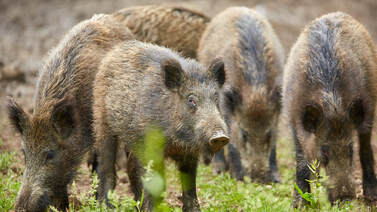 Feral pigs or wild boar to some are becoming a rising problem for airports and airport managers who are responsible and held accountable for providing a safe and wildlife risk free runway for planes arriving and departing. Feral pigs which are one of the most invasive species here in the United States but are wreaking havoc worldwide. Hunters, Wildlife Biologists, and the Government Agencies have been ramping up efforts to get the population in check to reduce the number of costly accidents and crop devastation. estimates there are at least 6 million feral swine spread throughout some 35 states. They have been a particularly virulent problem throughout the south, especially in Texas, where their incessant rooting and voracious eating destroy crops, erode soil and uproot tree seedlings, causing deforestation. They also carry disease like pseudorabies and swine brucellosis. The U.S.D.A. estimates, conservatively, that invasive swine cause upward of $1.5 billion in damage annually to all manner of agriculture, including rice, corn, and grains. But what about airports? Here are a few stories where pigs have cost the aviation industries a substantial amount of money and airfield damages. An Etihad Airways Airbus A320 in January of 2020 collided with a wild boar when landing in the capital of Pakistan. The Aviation Herald reports that registration A6-EII was performing flight EY-233 from Abu Dhabi. However, as it touched down on the runway at Islamabad Airport, the crew noticed that the plane had hit an animal. The plane did not seem to be too affected by the collision as it continued to roll out and taxi onto the apron. Thereafter, staff went to see what happened when A320-200 was landing. While observing the ground, a wild boar was found lying on the runway. In 1988 at Jacksonville International Airport Lt. Col. Sam Carter was rolling down the runway at 160 mph after landing when saw ″a brown blur″ and felt a bump before his Air National Guard jet veered toward a ditch and a stand of pines. A pair of wild pigs that wandered off course got hit by an F-16 fighter, forcing the pilot to eject as the jet veered off a runway and crash. Carter who was forced to eject from the jet before it collided with the nearby woods! This incident destroyed a $16 million dollar jet. In 2008 at the Will Rodgers World Airport outside Oklahoma City, Oklahoma, a group of feral hogs had been digging under the airport fence and eventually broke through wondering around the airfield at night. The airport has a wildlife mitigation team with biologists from the United States Department of Agriculture. Those biologists had been tracking the hog for several days. In the end the pigs had caused enough damage to the airfield and the fence that biologist had to shoot them because they kept coming back. Want to talk about severe long-term damage ask Williston Municipal Airport’s historic grass runway. The grass runway, spanning 2,600 feet, had been closed to the public for about a year, but not to the hogs. Since World War II, the runway has been open on and off. Despite local efforts, wild hog damage and maintenance issues are preventing the runway from getting approved by the Federal Aviation Administration. Without the FAA’s blessing, if an accident were to happen on the grass runway, the city would be held liable. Damage from the feral hog infestation added another hurdle to seeking federal approval. Clearly these are just a few examples and there are many more all over the world. Here in the United States as this invasive species continues to grow in numbers and the risk of more planes colliding with them on the rise, its easy to see why Feral Pig Management is in high demand. Loomacres - 800-243-1462 Bringing Wildlife Management to a Higher Level ©
1 Comment
|
Sales & Marketing
|

 RSS Feed
RSS Feed